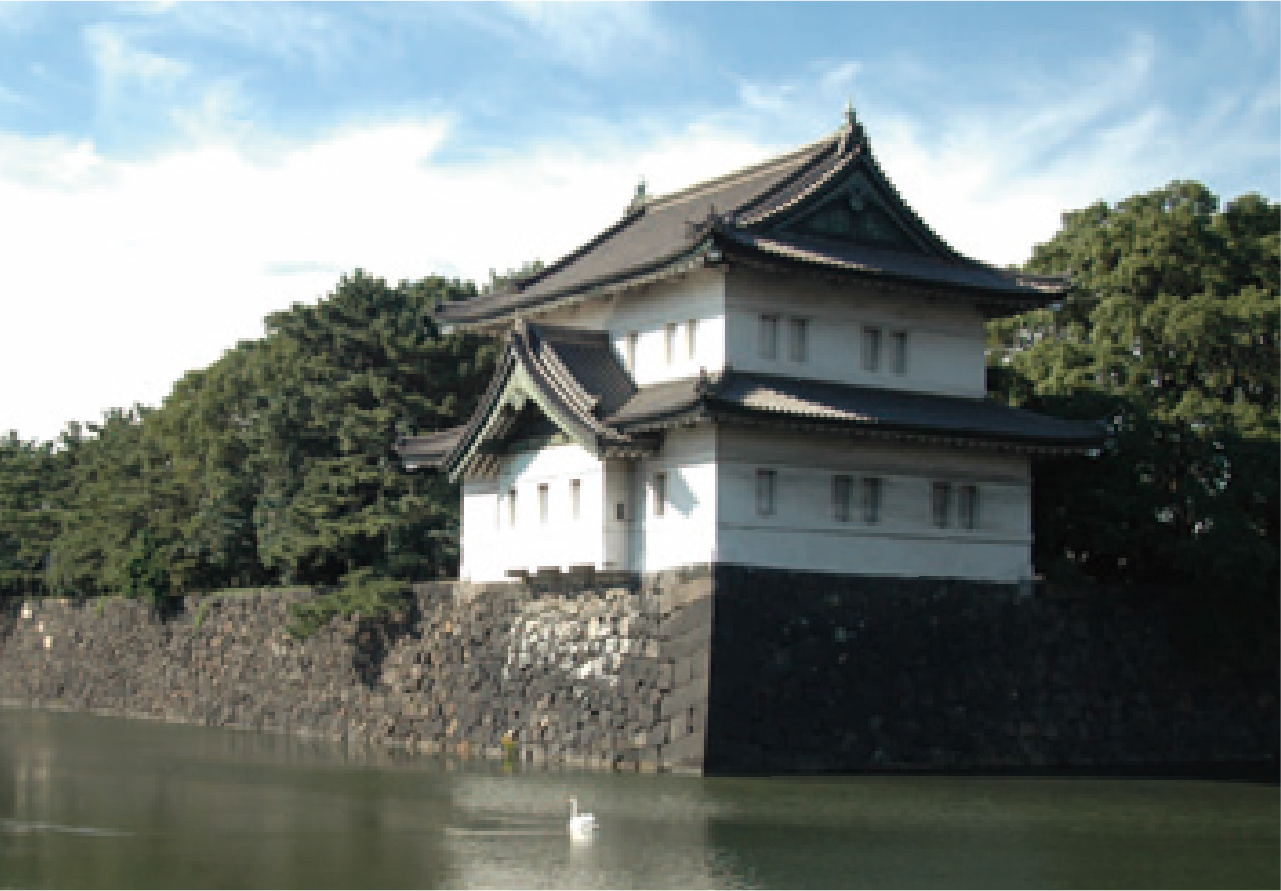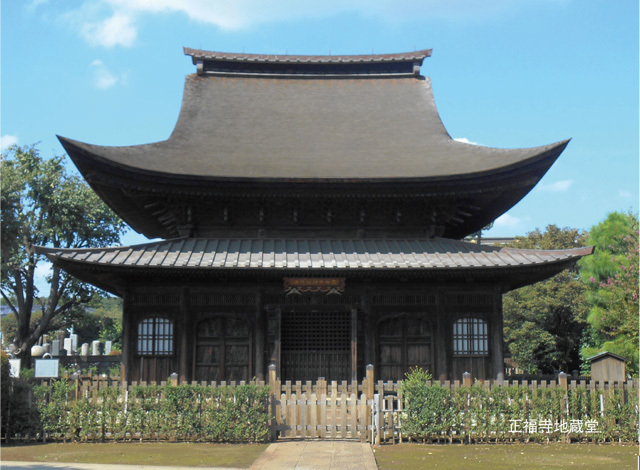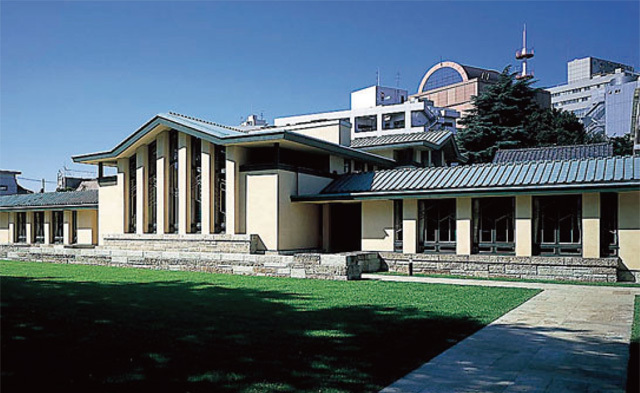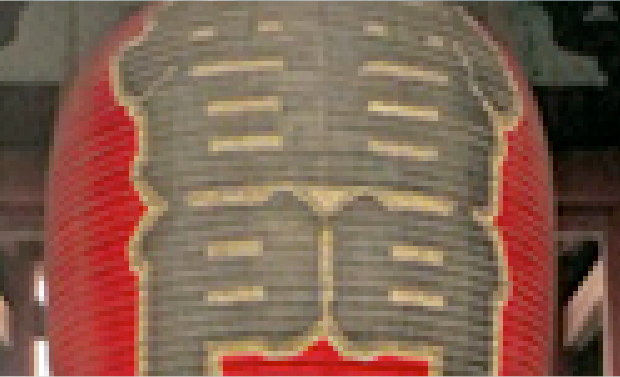
Let's take a stroll around Asakusa!
Taito city Course (Asakusa)
One of the remarkable sightseeing spots in Tokyo - Asakusa! Asakusa was developed as a temple town of Senso-ji Temple. Although its old townscape of the Edo period had gone caused by the Great Kanto Earthquake and the World War II, Niten-mon Gate in Senso-ji Temple and Asakusa-jinja Shrine which escaped damage from the disasters are designated as Important Cultural Properties.
This walking course is selected to see the history and culture with its modern energy of Asakusa.
Only famous Kaminari-mon Gate and Nakamise Street are not enough to tell you the whole of this town. Let’s take a stroll around Asakusa and find its new view point!
Let's take a stroll around Asakusa!
The place name "Asakusa", which often appears in the popular period novel "Onihei Hanka-cho" written by IKENAMI Shotaro, was recorded for the first time in the history book "Azuma Kagami" in the Kamakura period. It is recorded in the book that a carpenter of Asakusa, Musashi Province was invited to build Tsurugaoka Hachiman-gu Shrine in Kamakura in 1811, because there was no expert. There is also a record that three monks went from Senso-ji Temple to Kamakura to attend the memorial service of the Cloistered Emperor Goshirakawa in 1192. This is the first appearance of the name "Senso-ji Temple". The surroundings of Senso-ji Temple were donated as an estate of the temple after the medieval period and developed as a temple town.
In the Edo period, while the northwest of the temple was used for residences of feudal lords or farmlands, many merchant houses were built in the southern of Kaminari-mon Gate, and Senso-ji Temple became popular among the common people. Many tea-houses were opened along Nakamise Street to the south, and shows in booths and performances such as spinning tops were run at Okuyama in the east of the main temple. The botanical garden "Hana-yashiki" was opened in 1853. The Asakusa area developed as a major entertainment town.
After the Meiji Restoration, the precincts of the temple was requestioned by the new government and came to be managed by Tokyo as the first public park in Japan "Asakusa Park" designated in 1873.
The twelve-storied tower "Ryoun-kaku", built in 1890, used to be a landmark commanding the whole area of Asakusa. The program "100 beauties" gained great popularity among people, pasting up the photographs of 100 geisha from the 3rd floor to the 6th floor of the tower and holding a popular vote. Asakusa Opera was shown at the cinemas standing side by side under "Ryoun-kaku" and enthusiastic opera fans called "Pera Goro" used to strutted in Asakusa Park. While such a new entertainment, the traditional shows like sword dance or storytelling on street, were also performed everywhere. The characteristic popular culture mixing old and new came to be created around Asakusa.
The tasteful townscape of Asakusa in the Edo period, harmonizing affection for the Edo period with romanticism in the Taisho period, almost disappeared by the Great Kanto Earthquake in 1923 and the Great Tokyo Air Raids in 1945.
The designation of Asakusa Park as a public park was cancelled partly in 1951 and the land was turned back to Senso-ji Temple. The temple buildings were reconstructed one after another in its precincts, such as the reconstruction of the main building in 1958. As the facilities of entertainment, the entertainment park "Asakusa Hana-yashiki" reopened in 1947 which was closed during the war, and theaters and places of entertainment were constructed on the reclaimed land of the pond called "Hyotan Ike".
The attractiveness of Asakusa is the mood of Edo caused by Denbo-in Temple, Niten-mon Gate, Asakusa-jinja Shrine, etc., that were survived the two big disasters, and also the atmosphere caused by the modern popular entertainment culture of Asakusa has been handed through hundreds years.
Walking Course Highlights
Route Map
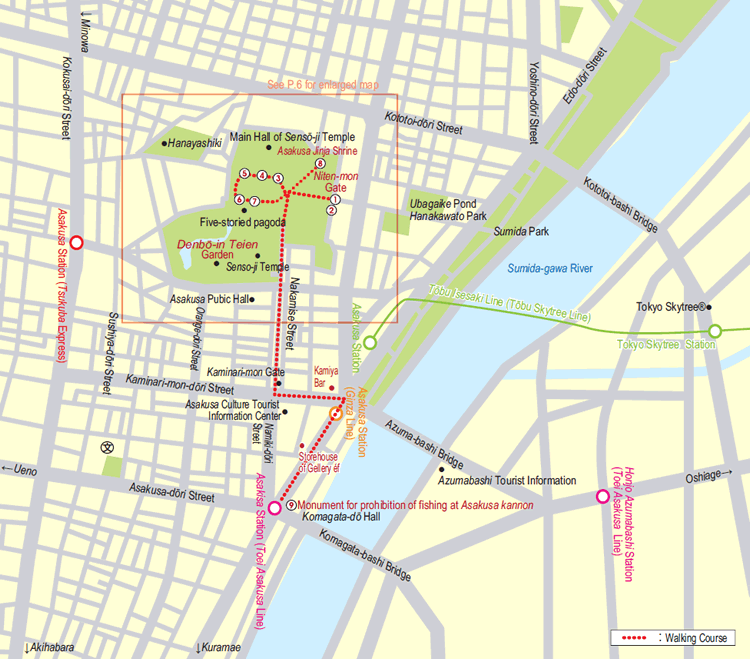

Column
Brochure (PDF)
Taito city Course (Asakusa)
Walking around Senso-ji Temple
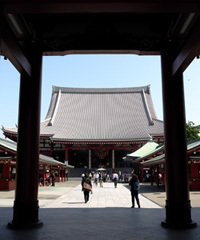
Main Hall of Senso-ji Temple
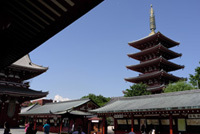
Five-storied pagoda in Senso-ji Temple
The beginning of Senso-ji Temple is said as follows: in 628, HINOKUMA no Hamanari and his brothers Takenari found a small statue of Buddha in their casting net at Miyato-gawa River (current Sumida-gawa River). When HAJI no Nakatomo recognized the statue as Sho-kanzeon Bosatsu, Bodhisattva Kannon, he became a monk and remade his residence into a temple.
In the medieval period, the estate of the temple had been gradually expanded by the donations from dominant figures, such as MINAMOTO no Yoritomo and ASHIKAGA Takauji. In the Edo period, the temple was designated as Kiganjo of shogunate (the temple for the TOKUGAWA Clan to pray) by the first shogun TOKUGAWA Ieyasu and had been heavily protected. However, when the head monk Chuun was removed from his position because he broke a taboo of the 5th shogun Tsunayoshi, Senso-ji Temple was put under the control of Kan'ei-ji Temple.
After establishing as a popular place of worship among the commonpeople, Senso-ji Temple came to be one of the well-known sights in Edo, where many tea-houses opened in the precincts and show booths stood side by side. It is said that Nakamise Street, which is the most popular sightseeing spot in Asakusa today, begun when neighbors were permitted to open temporary shops around 1685, instead of sweeping in the precincts.
In the Meiji period, waves of modernization also arrived at Senso-ji Temple, where a railroad for horsecar was laid on the street in front of Kaminari-mon Gate and Western-style brick buildings were built along Nakamise Street. The old townscape of Asakusa in the Edo period got a big damage from the Great Kanto Earthquake and all structures of the temple, and were burned down in the Great Tokyo Air Raids without Denbo-in Temple, Niten-mon Gate and Asakusa Shrine.
After only three months from the end of the war, the temporary main building (current Awashima-do) was built on the ruins of the previous, and the principal image evacuated into the earth rested there. The current main building, Kaminari-mon Gate and Hozo-mon Gate (former Nio-mon Gate) were rebuilt one after another in the thirties of the Showa period. The five-storied pagoda was also reconstructed in 1973, though on the different place from the previous. Senso-ji Temple becomes the present state in this way.
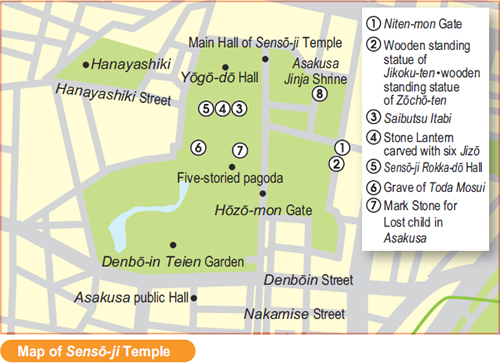
1 Senso-ji Niten-mon (Niten-mon Gate)
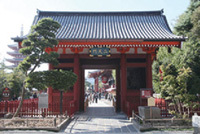
Niten-mon Gate in Senso-ji Temple
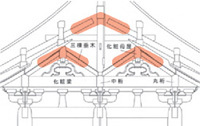
Mitumune-zukuri
This is called
Mitsumune-zukuri style, because it looks like having three ridges of roof.
Senso-ji Temple has suffered a lot of calamities in its long history. The temple buildings were burned down twice during the Kan'ei era in the early Edo period. As a consequence, Tosho-gu Shrine in the temple was relocated to Momiji-yama Hill in Edo Castle in 1636.
It is said that Niten-mon Gate originally used to be the gate of that Tosho-gu Shrine. The original gate was built in 1618, but the current is estimated to be rebuilt in 1649.
By the Ordinance Distinguishing Shinto and Buddhism in 1868, the accompanied sculptures with the gate were changed two gods of Shinto to two Buddhist gods Komoku-ten and Jikoku-ten, who are the guardian gods of the west and the south in Buddhism, were dedicated by Tsurugaoka Hachimang. Shrine in Kamakura. Therefore, the gate was renamed to Niten-mon.
Niten-mon Gate has a quite massive structure with eight pillars and a width of 8.13 meters at the beam. The roof with formal tiles is made in the Kiritsuma-zukuri style. The gate itself is built in the Mitsumune-zukuri style, which is one of the gate style hanging two roof-like triangular ceilings in the front and rear of the gate. Because it looks like having three ridges of roof, the style is called "Mitsumune-zukuri" ("Mitsumune" means three ridges). This style was frequently adopted by the structures in relation to the Tokugawa shogunate, such as Ky. Taitoku-in Reibyo So-mon Gate (built in 1632, in Minato City). The gate is entirely coated with red painting, but these red-colors are different according to parts; the lower part is lacquered by blackish Indian red and the upper part is painted with red lead of a light orange color.
Opening Information of the Senso-ji Temple
- Opening Days:
- All year
- Opening Times:
- All day
- Fee:
- Free
Taito city Course (Asakusa)
2
Mokuzo Jikoku-ten Ryuzo, Mokuzo Zocho-ten Ryuzo
(Wooden standing statue of Jikoku-ten, Wooden standing statue of Zocho-ten)
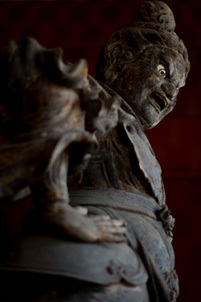
Wooden standing statue of Zocho-ten
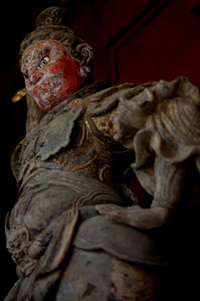
Wooden standing statue of Jikoku-ten
Jikoku-ten and Zocho-ten are two of the Four Devas (others: Komoku-ten and Tamon-ten). The Four Devas are the guardian gods of Buddhism, represented by a general armed with armor. Because it is said that Jikoku-ten protects the east, Zocho-ten does the south, Komoku-ten does the west and Tamon-ten does the north, these sculptures are frequently arranged around Shakamuni triads (mainly at four corners).
The previous sculptures installed in this gate suffered from the Great Tokyo Air Raids on March 10, 1945, at the place repairing. Therefore, they had had no sculptures in Niten-mon Gate for a while.
Nearly ten years later, Kan'ei-ji Temple in Ueno worked on the repair of Gen'yu-in Reibyo Chokugaku-mon Gate since1956. The left and right wings attached to the gate were decided to be withdrawn, because they were proved to be attached in the Meiji period, and two wooden sculptures Jikoku-ten and Zocho-ten arranged in the wings were obliged to take away. In 1957, Senso-ji Temple, which had been carrying on the improvement of the precincts aiming for the reconstruction of the main building, inherited these sculptures to install to the unoccupied Niten-mon Gate.
These were restored to its original state from 2007 to 2009. In the restoration, a signature "Dai-busshi Hokkyo YOSHIDA Hyobu" by Indian ink was found on the inside of the head of the sculpture of Zocho-ten. It showed that they were made by the official sculptor of Buddhist images "YOSHIDA Hyobu Fujifusa", who was active in Kyoto in the late 17th century AD.
Opening Information of the Senso-ji Temple
- Opening Days:
- All year
- Opening Times:
- All day
- Fee:
- Free
Taito city Course (Asakusa)
3
Saibutsu Itabi
(Board monument of Saibutsu Itabi)
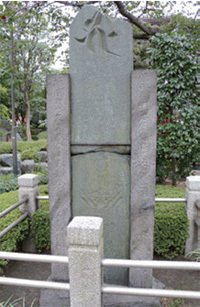
Saibutsu Itabi;Photo credit: Courtesy of Taito City Board of Education

Rubbed Copy of Saibutsu Itabi;Photo credit: Courtesy of Taito City Board of Education
Saibutsu Itabi is a board monument erected on the pond in front of Yogo-do Hall at the east of the main building of Senso-ji Temple,. "Itabi" is a kind of the stupas, which is made of rectangular stone board and has a triangular top. The stone stupas made of chlorite schist produced in Chichibu, Saitama Prefecture, are called "Aoishi Toba" (blue stupa), and have been preferred because of the beauty of their colors and shapes.
Saibutsu Itabi are engraved the followings on: a large Seed-Syllable of Shaka Nyorai at the center of the upper part, a Jizo Bosatsu standing on a lotus calyx and a vase with lotus flowers under the Seed-Syllable, an image of child acolyte of Buddhism on the right side of Jizo Bosatsu and a sentence that Saibutsu hoped for the happiness of his family in the current world and the next. Its builder Saibutsu had been supposed to be "KAMATA Saburo Nyudo Saibutsu" who was a magistrate ordered to construct the bank in Shimo Kobeno-sho Manor, Shimousa Province, according to Article August 29, 1253 in the history book "Azuma Kagami". However, it is unclear because there are several candidates of Saibutsu.
Saibutsu Itabi was destroyed by a storm in October, 1742. Then, it was broken into three, according to the topography "Edo Meisho Zue". The top part is said that it had been by the side of Inari-sha Shrine in Denboo-in Temple, but it is unfortunately missing. The remaining parts was reset by ten volunteers in 1814, supported by side pillars.
This board monument is estimated to be raised from the late Kamakura period to the early Muromachi period. Its size is 217.9 cm in height and 46 cm in width; this is the largest Aoishi Toba (blue stupa) in Tokyo. Saibutsu Itabi is important, not only as a valuable material for understanding the medieval belief, but also as a typical example of huge board monument.
Opening Information of the Senso-ji Temple
- Opening Days:
- All year
- Opening Times:
- All day
- Fee:
- Free
Taito city Course (Asakusa)
4
Roku-jizo Ishi-doro
(Stone Lantern carved with six Jizo)
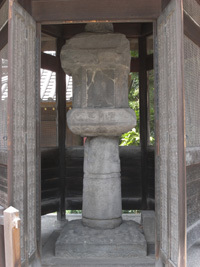
An image of Jizo is carved on six faces each of the stone lantern;
Photo credit: Courtesy of Taito City Board of Education
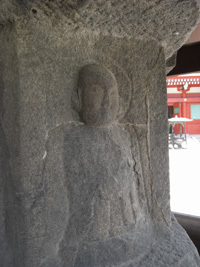
Full view of Rokujizo Ishi-doro;
Photo credit: Courtesy of Taito City Board of Education
The stone lantern standing at the front of Yogo-do Hall in Senso-ji Temple is about 180 cm in height and carved an image of Jizo on each face of hexagonal Hibukuro (burning place of lantern). Unfortunately, these images and inscribed letters are illegible at present, caused by weathering and damage by fires.
It is unknown when this stone lantern was made. According to one theory, it is said that "KAMATA Hyoenojo Masakiyo" built it when he visited Senso-ji Temple with his leader MINAMOTO no Yoshitomo during the Kyuan era (1145-51). However, according to another, it is said to be built during the Oan era (1368-75). In any case, this is estimated to be one of the oldest stone lantern in existence in Tokyo.
Originally, it was located at the foot of Azuma-bashi Bridge east of Kaminari-mon Gate; therefore, the bank of Sumida-gawa River around there was said to be called "Roku-jizo Kagan". It had been buried from the base to the lower half of the pole stone, until it was moved to the present place in 1890 in replanning of streets. This stone lantern is protected in the small hall with roof now.
Opening Information of the Senso-ji Temple
- Opening Days:
- All year
- Opening Times:
- All day
- Fee:
- Free
Taito city Course (Asakusa)
5
Senso-ji Rokkaku-do
(Senso-ji Rokkaku-do Hall)
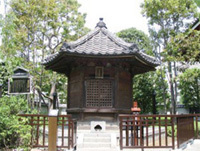
Senso-ji Rokkaku-do Hall
This hall is supposed to be the oldest building in Senso-ji Temple at present, because, it has used the old architectural froms. Furthermore, according to "Senso-ji Shi" (History of Senso-ji Temple, edited in 1813), there is a mention that the hall was built on a well dug in 1618. Actually, the bottom of the hall is supported by the hexagonal wooden foundation and the stone base, and a well-shaped hole underground with piled stones of eleven steps is dug to a depth of about 1.5 meters.
The structure style: Sangawara-buki roofing, vermillion lacquered, hexagonal hall, the center of the hall with a diameter of 1.82 meters, 0.91 meters interval between pillars of a side. Such a style is very unique in Tokyo. The rafters supported the roof was made in "Ogi-taruki" style that the rafters spread radically like umbrella ribs. This style of rafter, especially hexagonal, is difficult to work and set up, so that is an opportunity for carpenters to show their skills.
"Higiri Jizo-son" is enshrined in Rokkaku-do Hall, which is said to have a miraculous efficacy surely if one prays on the fixed date. Therefore, this hall is also called "Higiri Jizo-do" ("Higiri" means the fixed date).
The hall had been originally located about 22 meters east from the present, but was moved to the present place in 1994. The original place is marked on the south stylobate of current Yogo-do Hall.
Opening Information of the Senso-ji Temple
- Opening Days:
- All year
- Opening Times:
- All day
- Fee:
- Free
Taito city Course (Asakusa)
6 TODA Mosui Haka (Grave of TODA Mosui)
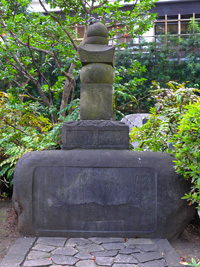
Grave of TODA Mosui
TODA Mosui (1629-1706) is a Waka poet in the Genroku age of the Edo period. He was born the 6th son to WATANABE Kenmotsu Tada in Sunpu-jo Castle, and was adopted by his uncle TODA Masatsugu after his father's death. His original name was Tanomu, but he changed own name into Yasumitsu later. His pseudonym is Moemon or Mosui.
He had served under HONDA family, Mikawa Okazaki Domain for a period, but became a monk and lived near Senso-ji Temple. He is known as an aggressive critic of the traditional poem study in name only. His most important works are the topography "Murasaki no Hitomoto",the chronicle "Gotodai-ki", the book of poem study "Nashinomotoshu",etc.
His gravestone was found at Bansho-in Temple in Ushigome area and was moved in Asakusa Park in 1913. The gravestone is composed of three parts: from the bottom, the base made of natural stone, the foundation stone of Hokyointo pagoda and the Gorin-to pagoda.This Gorin-to pagoda was built by Toda Mosui himself before his death for the repose of his soul; such pagoda is called Gyakushu-to pagoda.
Opening Information of the Senso-ji Temple
- Opening Days:
- All year
- Opening Times:
- All day
- Fee:
- Free
Taito city Course (Asakusa)
7 Asakusa Maigo-shirase Sekihyo (Mark Stone for Lost Child in Asakusa)
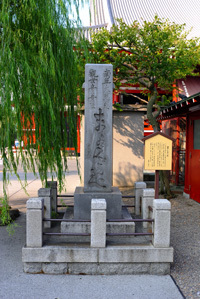
Mark Stone for Lost Child in Asakusa
This mark stone is standing at the front of the left side of the main building of Senso-ji Temple. It is carved "Namu Daijihi Kanzeon-bosatsu Mayoiko-no Shirube" and had been used for exchanging information about lost child in the Edo period.
It is carved "Shirasuru-kata (to let know)" on the right side of the stone, and people put the paper here, to give the information about a lost child or a missing person whom they were keeping.
On the left side, "Tazunuru-kata (to ask)" is carved, and people put the paper here, to give information about one who they are looking for. In the Edo period, people looked for a lost child or a missing person checking these papers.
This mark stone was raised on March, 1860 by MATSUDAYA Kahei, who was an owner of geisha house in Shin Yoshiwara, in order to mourn for the dead in the red-light district in the Ansei Great Earthquakes happened at about ten o'clock at night on October 2, 1855. The dead and wounded by that earthquakes estimated at magnitude 6.9 and accompanied fires are said to reach 1000 people in Yoshiwara area.
It was originally located in front of Nio-mon Gate (current Hozo-mon Gate), but collapsed in the World War II and a part of the foundation stone barely remained. The present mark stone was restored in 1957.
In Tokyo, a same mark stone for lost child remains at the foot of Ichikoku-bashi Bridge over Nihonbashi-gawa River. In the collection of short stories "Genshoku Edo Goyomi" by MIYABE Miyuki, you can find a mark stone for lost child (not one in Asakusa) in the story "Maigo no Shirabe".
Opening Information of the Senso-ji Temple
- Opening Days:
- All year
- Opening Times:
- All day
- Fee:
- Free
Taito city Course (Asakusa)
Walking around Asakusa-jinja Shrine
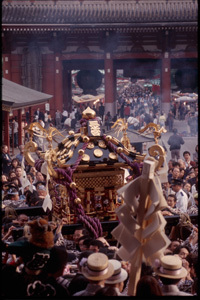
"Sanja Matsuri Festival" ;
Photo credit: Courtesy of Suga collection, Owned by Taitto City Board of Education
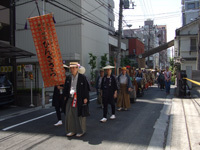
A scene of Binzasara Jyunkto parade
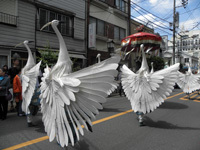
A scene of Shirasagi-no-mai Dance (Dance of Egrets)
in the big parade
When going through the stone Torii standing on the east side of the main building of Senso-ji Temple, you arrive in the precinct of Asakusa Jinja Shrine, which is enshrined local Shinto deities of the whole Asakusa and commonly known by "Sanja Sama" famed for Sanja Matsuri Festival. The beginning of this shrine is that people built Sanja Gongen-sha Shrine (current Asakusa Jinja Shrine) for worshipping three persons, Hinokuma brothers and Haji no Nakatomo, who are deeply related to the story about the beginning of Senso-ji Temple (see above). Therefore, the crest of this shrine is "Mitsuami" modeled on three casting nets. It is supposed that this shrine had already been built until the end of the Kamakura period, because there is a record that one of the Shinto rituals "Funatogyo" (carrying the sacred object across a river by boat) was performed at that time.
The main building of the current shrine was rebuilt in 1649 donated by the 3rd shogun TOKUGAWA Iemitsu, because that was repeatedly suffered collapses by fires.
And at that time Asakusa Toshogu Shrine in the precinct of the temple moved into the Edo Castle, but the image of Ieyasu (first TOKUGAWA shogun) in the Toshogu Shrine was kept at Asakusa and came to be enshrined together with three deities of Sanja Gongen-sha Shrine and was served by Senso-ji Temple. How-ever, by the Ordinance Distinguishing Shinto and Buddhism in the Meiji period, Sanja Gongen-sha Shrine was independent from Senso-ji Temple and changed its name into the current. Hikan Inari Shrine also remains in the precinct, which was built by the request of SHINMON Tatsugoro, who was deeply connected with Asakusa and asked Fushimi Inari Shrine to make a branch shrine.
Sanja Matsuri Festival, held at Asakusa-jinja Shrine every year from Friday to Sunday near in May 17 and 18, is one of the major festivals in Tokyo. It is the very lively festival that three Mikoshi (portable shrine), where each deity enshrines, are carried around 44 towns of Asakusa. According to the chronicle "Senso-ji Engi", the shrine received the oracle "Make Mikoshi, hold the ritual Funatogyo, and pray for world peace," in March of 1312. This is said to be the beginning of Sanja Matsuri Festival. Once, the festival held every year on March 18, which is the day HINOKUMA brothers found the statue of Buddha, and the ritual Funatogyo held every other year. In the Edo period, eighteen towns of Asakusa, its number is associated with the day 18th, competed the luxuriousness of their festival floats.
In the Meiji period, the ritual Funatogyo and the parade of festival floats disappeared in the festival, and its schedule was changed into the two days, on May 17 and 18. The parade of Mikoshi came to hold in place of the festival floats. In 1963, the schedule was changed again into the current. At present, a big parade holds on the first day (Friday); the dancers of Binzasara-mai Dance, Teko-mai Dance, Shirasagi-no-mai Dance and so on are marching around the whole Asakusa, guided by the music of Japanese orchestra and the song of scaffolds. On the second day (Saturday), the parade of about 100 small Mikoshi made by each town of Asakusa holds, and three large Mikoshi (Ichino-miya, Ninomiya and San-no-miya) are carried around 44 towns of Asakusa on the final day (Sunday).
8
Asakusa Jinja
(Asakusa-jinja Shrine)
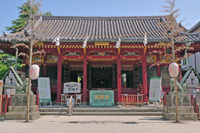
Exterior of Votive Offering Hall of Asakusa-jinja Shrine
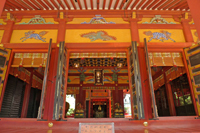
Interior of Votive Offering Hall of Asakusa-jinja Shrine
The current Asakusa-jinja Shrine was reconstructed together with the buildings of Senso-ji Temple in 1649, after all of them had been burned down in 1642. According to the chronicle "Senso-ji Shi", their reconstruction costs were quite huge; the buildings of the shrine cost more than 1200 ryo (money at that time).
The buildings of the shrine are built in a style resemble to the Gongen-zukuri style that Hon-den, Hei-den and Hai-den are connected by corridors, but adopt slightly unique structures. Hai-den is 7 ken (about 12.7 m) width at the beam and the dedication of Binzasara-mai Dance hold here in Sanja Matsuri Festival. Hon-den is in the Sangen-sha Nagare-zukuri style, and HINOKUMA brothers and HAJI no Nakatomo are enshrined here.
The whole buildings of shrine are lacquered by Bengal red, but the fittings are black lacquered, which contrast well. The small walls above the beams are vivid, where holy animals such as Chinese phoenix, Kirin and dragon symbolizing a good omen are painted with brilliant color on the golden ocher background. These lacquer and paintings were repaired in 1994-95, because the deterioration over time came to stand out since the repair in 1963. The brilliantness of revived colors is amazing. This shrine is a precious cultural property, because it retains the atmosphere of those days as it was still now even if 360 years and over have passed since its construction, escaping damage from the Great Kanto Earthquakes and the World War II.
Opening Information of the Asakusa-jinja Shrine
- Opening Days:
- All year (Only the precincts of the shrine)
- Opening Times:
- All day
- Fee:
- Free
Taito city Course (Asakusa)
9 Asakusa Kannon Kaisatsu no Hi (Monument for prohibition of fishing at Asakusa Kannon)
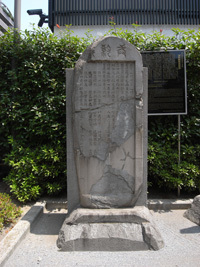
Monument for prohibition of fishing at Asakusa Kannon;
Photo credit: Courtesy of Taito City Board of Education in the big parade
When there were no car and no train, there was a warf in the area of Komagata-bashi Bridge over Sumida-gawa River, and crowded with the river traffic. People who came to Asakusa by boat used to worship Komagata-do Hall, said to be built in 942, at first and next to Senso-ji Temple.
Komagata-do Hall was built on the place of the bank, where HINOKUMA brothers found the statue of Buddha, the principle image of Senso-ji Temple.
Senso-ji Temple was designated as a place for players of Edo shogunate by TOKUGAWA Ieyasu. Afterwards, in 1642, during the era that the 5th shogun Tsunayoshi, who is known for the ordinances of animal protection, this area was prohibited from fishing.
The range was from south Suwacho (current Komagata, Taito City) to north (Asakusa 7-chome) around Komagata-do along the Sumida-gawa River. The area is about 10 ha, more than 2 times the area of Tokyo Dome.
In the next year, Senzon, the 4th Gon Sojo of Senso-ji Temple, raised this monument in the precincts of Komagata-do Hall, commemorating the designation as the area of prohibiton of fishing.
This monument is a precious historical material, which tells the belief in the Genroku age of the Edo period.
Opening Information of the Asakusa Kannon Kaisatsu no Hi
- Opening Days:
- All year
- Opening Times:
- All day
- Fee:
- Free
Taito city Course (Asakusa)
Denbo-in Teien (Denbo-in Teien Garden)
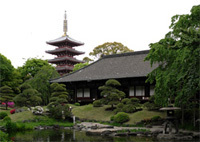
Walking on Nakamise Street to Hozo-mon Gate and crossing Denbo-in-dori Street, you can find a solemn front gate at the secluded place from the left. Going through the front gate, you arrive at Denbo-in Temple which is the office of Senso-ji Temple and also the residence for head priest for generations. The garden covering the greater part of Denbo-in Temple is separated from the bustle of tourists, and a calm air is blowing among the garden. Here is one of the few temple gardens from the Edo period in Tokyo.
This garden is estimated to be originally landscaped in the Middle Ages. Old drawings and the style of landscape show that the present allocation of space arranging ponds on the north and west side of buildings is unchanged from the early Edo period.
Looking at the west pond from Ojoin (large drawing room) facing the garden, you see a large artificial hill on the left, the stone arrangement which represents a three-step dry fall from the top of the hill and the sandy beach which represents the water surface. Turning your eyes to the center, an undulating shore in islands spreads out.
Strolling around the pond and standing on the island on the opposite side of Ojoin, you can see a full view of the fivestoried pagoda through the sandy beach arranging stepping-stones and Ojoin. Viewing the north shore which is gently undulating in contrast to the west, it is better to see standing on the stone bridge across a stream joining each pond.
Denbo-in Teien was a secret garden as even the daimyo were not easily allowed to visit, because Denbo-in Temple was used as Gozen-sho (the place Tokugawa shoguns took a meal or rest) when they came. However, when the precinct of Senso-ji Temple was designated as a public park in 1873, this garden had been open to the public by Tokyo from 1930 to the outbreak of the Pacific War. At present, here is open to the public for a certaion period by Senso-ji Temple. This garden hands down the atmosphere of the Edo period to now, which was mostly lost from Asakusa in the Great Kanto Earthquakes and the Pacific War.
Opening Information of the Denbo-in Teien Garden
- Usually not open to the public
Taito city Course (Asakusa)
Aasakusa Jinja no Binzasara (Binzasara Dance of Asakusa-jinja Shrine)
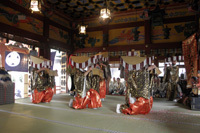
A program "Katazoroe" of Binzasara-mai Dance in Asakusa-jinja Shrine
Binzasara is a musical instrument which consists of 108 wooden strips connected to each other at the side ends in the bendable state inward (a strip:15 cm in length and 6 mm in thickness).To make sound, people grasp both ends of the instrument and wave it to rub these wooden strips. The dance with this instrument is dedicated on the first day of Sanja Matsuri Festival.
On the opening day (Friday) afternoon, the performers of Binzasara-mai Dance line up at the middle of the big parade, who are a couple of dancers with large red and blue Shishi-gashira (lion mask), a drummer with a big drum wearing a red long wig to his knee, three players of Binzasara covering their face with Ayai hat,two drummers with small drums, two players of Japanese flute and so on. When the big parade arrive at the shrine, only that performers are allowed entering the building of shrine. At the worship hall, they dedicate three kinds of Shishi-mai Dance and four kinds of Sasaramai Dance and pray for a bumper harvest. In the chronicle "Sensoji Engi" which has the illustrations of Binzasara-mai Dance when Sanja Jinja Matsuri Festival started in the end of the Kamakura period. This performance is a precious Intangible Folk Cultural Property, which passes on the traditional performing art since the medieval period to us.
Taito city Course (Asakusa)
Kamiya Bar Honkan (Kamiya Bar)
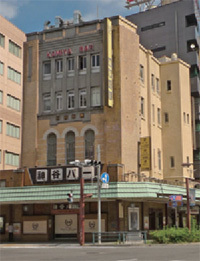
Kamiya Bar
Kamiya Bar is one of the landmarks in Asakusa, which has stayed at the approach to Azuma-bashi Bridge since before the Great Kanto Earthquakes.
In the Meiji period, when the precincts of Senso-ji Temple became a public park, many entertainment facilities, like a theater, came to be built on the west of the temple. Especially, the Denki-kan Cinema was very popular for the cultured people. The word "Denki (electricity)" symbolized a novelty at that time. The Kamiya Bar served the strong cocktail with has 45 percent alcohol content was named "Denki-bran". This cocktail and wine were also novelty and appeared in many literary works at that time. Kamiya Bar was founded in 1880 and remodeled into a Western-style bar in 1912. This is said to be the first bar in Asakusa.
The present building was built with a reinforced concrete in 1921 in the forefront of time. The big triple arch with round windows at the front is characteristics.
Opening Information of the Kamiya Bar
- Opening Days:
- All year(Allowed to look at only the exterior)
- Opening Times:
- All day(Allowed to look at only the exterior)
- Fee:
- Free(Allowed to look at only the exterior)
Taito city Course (Asakusa)
Gallery éf Gura (Storehouse of Gallery éf)
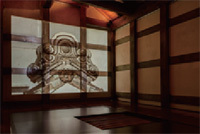
The area of the gallery on the south Kaminari-mon Gate, near Azuma-bashi Bridge, along Sumida-gawa River, used to be called "Zaimoku-cho (timber town)". Actually, there had been a lot of wholesale merchants dealt in timbers or bamboos.
This storehouse was a household storehouse of a wealthy timber merchant "TAKEYA". Many residences and stores had stand side by side all through the area to Sumida-gawa River.
The structure of the storehouse is quite strong; it has big pillars and beams, and its plaster work on the wall is solid. There is an ink script under the beam of the second floor, which is the date of "August, 1868" and the name of "TAKEYA Chojiro 3rd". It is the year that the era name changed to Meiji, on September, 1868. This storehouse is a precious cultural property, handing down the atmosphere of the Edo period to now. At the present, it becomes the gallery accompanied with art space.
Opening Information of the Storehouse of Gallery éf
- Opening Days:
- All yearyear(Except on Tuesdays and temporary non-business days)
- Opening Times:
- 11:00~18:30(Varies depending on the type of exhibition)
- Fee:
- Free
 Café
Café
Tokyo Cultural Heritage Map
Would you like to go around cultural heritages? In Tokyo, there are various cultural heritages. This map helps you go around cultural heritages with efficiency during limited time in your trip. Japanese traditional temples and shrines, the cultural heritages concerned to most famous events and person in Japan and a lot of nature. This map introduces all of them widely! You must watch them and know the history and the culture of Tokyo!

SNS




